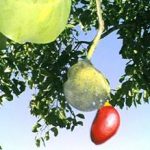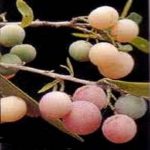TREE LIFE
September 2014
MASHONALAND CALENDAR
Sunday Sep. 21st (3rd Sun.) Return visit to Canon Kopje. On this visit we will look for the Swamp Forest. For those interested in sharing vehicles, we will meet at CABS Head Office at Northridge Park in Borrowdale at 7.30 a.m. for a prompt 7.45 departure. Those who wish to travel directly are, of course, always welcome to do so.
Saturday Sep. 27th (4th Sat.) Val d’Or by kind permission of Bill Clarke. For those who wish to car-share the meeting point is CABS Head Office at Northridge Park in Borrowdale. Meet 13.15 for a prompt 13.30 departure. Those who wish to travel directly are, of course, always welcome to do so.
TREE OF THE MONTH
Afzelia quanzensis
Family: Fabaceae, Subfamily: Caesalpinioideae. Common names: E: Pod mahogany; Nd: Umkamba; Sh: Mukamba.
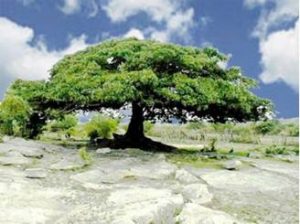
Afzelia quanzensis
Etymology: The genus Afzelia was named in honour of Adam Afzelius of Uppsala in Sweden (where Carl Linneus first developed his binomial classification) who lived in Somalia. The specific name quanzensis refers to the Cuanza River in Angola, where the tree was first found. Afzelia quanzensis is a deciduous, medium to large spreading tree, around 12-15 m in height but reaching 35 m under ideal conditions. It mostly grows in low-altitude woodland and dry forest.
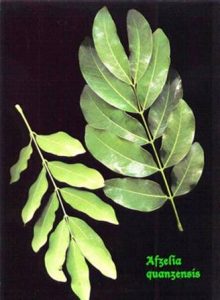
Afzelia quanzensis leaves
The leaves are paripinnate, alternate, with 4-6 pairs of opposite to sub-opposite leaflets. The leaflets are oblong-elliptic; 2.3-9 x 1.5-6 cm in size; hairless, shiny dark green above, paler green below and leathery.
The apex is broadly tapering to rounded, sometimes slightly notched and the base is broadly tapering. The margin is entire and wavy, the petiolules are kinked or twisted and the petioles between 2. 5 and 6 cm long
The bark is greyish brown and characteristically flaking in roundish woody scales, leaving pale patches.
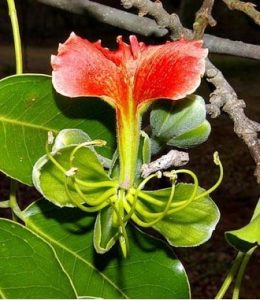
Afzelia quanzensis flowers
The flowers appear either in simple sprays or in once-branched racemes. The flower stalks are jointed and the bud is covered by 2 large bracteoles that fall away before the flower opens. The flower has 4 unequal sepals and a single petal 2.5-4.5 cm long that is clawed and expanded. It can be up to 3 cm wide and is red with yellow veining. The tree flowers from July to November.
The fruit is a large, flat, thickly woody pod, 10-17 cm long, dark brown, containing from 6 to 10 seeds embedded in a white pith.They are very distinctive, being dark blackish-brown in colour, oblong and up to 3 x 1.2 cm in size, each with a scarlet to orange aril enveloping the lower third to half of each seed.
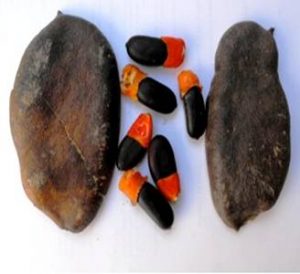
Afzelia quanzensis pods
The seeds are much in demand as ornaments and charms and are often strung into necklaces and sold as curios. The Zulu name for the tree – mkehli – means ‘betrothed girl’. The black seed with its red aril suggests the head of a maiden with the ochre head-dress which she wears in the period prior to her marriage.
The light red-brown timber has an attractive pattern, it is hard, works well and takes a fine polish. It has been used for building, plywood, furniture, panelling and for flooring blocks. Dugout canoes have been made from the tree trunks.
On the medicinal side an infusion of the roots provides a remedy for bilharzia – some of the infusion is taken orally and some is blown into the bladder through a very thin reed, but it is also used for certain eye complaints. Huntsmen wash in an infusion of the bark and roots which has steeped overnight to bring themselves luck. The powdered bark mixed with one’s own body oil is said to ward off attack or even provocation by others.
Sources:
Coates Palgrave, K. 1977. Trees of Southern Africa . Struik, Cape Town.
Flora of Zimbabwe website: www.zimbabweflora.co.zw.
Goldsmith, B. and Carter, D.T. 1992. The Indigenous Timbers of Zimbabwe. Forestry Commission, Harare.
Mullin, L.J. 2006. A New Zimbabwean Botanical Checklist of English and African Plant Names. Tree Society of Zimbabwe, Harare.
Swaziland’s Flora Database website: https://www.sntc.org.sz/flora/speciesinfo.asp?spid=1239
Van Wyk, B. and Van Wyk, P. 1997. Field Guide to the Trees of Southern Africa . Struik, Cape Town.
Wild, H. A 1972. Rhodesian Botanical Dictionary of English and Native Plant Names. Govt. Printer, Salisbury.
Photographs: JP Felu.
– J.P. Felu
CATAPÚ – TREE SOCIETY VISIT APRIL 2015
This is to let everyone know well in advance that another visit is being planned to Catapú in Mozambique next year. I have booked Mphingwe Camp for a week arriving Saturday April, 4 and leaving Saturday April, 11.
For those who have been before, little has changed, the distance is still the same and the EN1; the road from Inchope to Catapú still has many potholes, although some have been repaired others have appeared; the log cabins are still all the same; and most importantly the trees and walks are still as beautiful.
For those who might be interested in coming on this trip to give you an idea of the costs, the Aug 2014 rate of exchange is about 29 MT to $1. At Mphingwe all prices are given in Meticals but it is absolutely possible to pay in US$.
Accommodation is provided in comfortable 2-bed log cabins and will cost about $20 per person per night. There are two slightly more luxurious cabins, 21 and 23, each with two, three-quarter beds, en suite bathrooms and separate seating areas, which cost about $60 per night. Please let me know if you would like to book one of those.
There is a restaurant where drinks and meals are available. Meals will probably cost up to about $20-25 a day depending on whether you have steak or spaghetti. Coke and beers are $2-3 each, wine and spirits are also available.
Camping and self-catering are not permitted in accordance with Mozambique law.
Fuel (petrol) costs 49 MT per litre and is available at various places along the way. For those who don’t have SADC country’s passports (i.e. Zimbabwe or South Africa) a visa will cost about US$ 110. For those taking their own cars car insurance costs about US$25 or R150.
I am happy to take provisional bookings and will ask you to confirm your booking and pay a deposit in February. Hope you can join us.
– Meg Coates Palgrave megcp@zol.co.zw; +2634 886134; +2634 772 234 433
OUTING TO IMIRE GAME PARK 20 JULY 2014
Imire lies almost due south of Marondera, on the southern side of the Central Watershed and is at a slightly lower altitude than Harare of around 1400 m.
This outing was the first trial of car-sharing for the Tree Society and 4 vehicles met at the agreed point, the car park of the Mukuvisi Woodlands, and travelled on in two vehicles. Other members elected to make the journey independently.
After the turn-off in Marondera, we travelled on reasonably good, if rather dusty, gravel roads and made our way to the Bush Camp initially. There was quite a good turn-out of members. To my surprise we found ourselves in woodland dominated by Acacias. We were in fact just below the wall of a small dam. Our first task was to disentangle the Acacias. Four species were seen at the Bush Camp. The only one with curved paired prickles was Acacia galpinii, Monkey thorn, of which there were some very nice, large specimens. No flowers were of course visible at this time of year.
The other three species were all of the straight paired stipular-spine type. Acacia karroo, Sweet thorn showed off its distinctive dark bark below and reddish bark above. This species has relatively few (2-5) pairs of pinnae. These trees were also bearing copious quantities of the C-shaped pods. The second Acacia was Acacia sieberiana, the Paperbark Acacia with its pale papery bark. This has more pairs of pinnae (8-20) and numerous very small leaflets. The third species with spines was Acacia rehmanniana, the Silky Acacia with its distinctive reddish bark somewhat similar to karroo, but with many more (20-40) pairs of pinnae and very tiny leaflets. Just to complete the Acacias, later that morning, down by the stream, we saw Acacia schweinfurthii, the River climbing Acacia. This has a third type of arrangement of prickles; in this species they are not in pairs but are scattered along the stems.
To add to the fun, there was also Dichrostachys cinerea, the Sickle bush showing its single spiny branchlets. Examination with a lens also showed the stalked glands which are present between some of the pinnae on the leaf rachis.
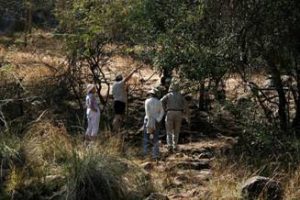
Botanising at Imire
After this opening session in the Mimosoideae, we set off into rather open woodland, heading towards a small river which was the outflow from the dam. Although we were in woodland, it was still rather riverine in its composition. We came across a specimen of a Carissa. Although most of the spines were simple, a significant number were forked. In plants of this type, confusion with Carissa bispinosa is possible. A specimen was collected and examined later at the Herbarium and this showed that the plant was definitely Carissa edulis and not bispinosa. It is a point to remember in the field that C. edulis may have forked spines and in this case it had a quite a number of forked spines. Another feature of bispinosa is its hairless stems.
The Wild Olive, or African Olive, was also present showing a great deal of variation from forms with tiny leaves to others with much larger ones. However, they all have opposite leaves and each leaf has a distinct spiny tip. The Latin name of this species has varied over time (e.g. Olea africana and Olea europaea subsp. africana) but current thinking is that it should be called Olea europaea subsp. cuspidata.
Whenever we travel to the Marondera-Wedza area there are two species one is likely to see. Neither occurs near Harare and we therefore don’t see them that often. They are Fagaropsis angolensis and Rhamnus staddo. I was certainly expecting to see them and so when we came across a distinctive looking tree with large imparipinnate leaves I immediately thought of Fagaropsis. As it is a Rutaceae, I reached for my lens confidently expecting to see translucent gland dots throughout the leaf lamina. However, there were none! There was some consternation as I tried desperately to think what the tree could be. Fortunately, a further closer look showed that gland dots were present but only near the margin. Checking in the books later confirmed that this is correct for Fagaropsis.
On the slope above the stream there was a large marshy area with water seeping out of the ground. Abundant in this area was a white-flowered herb; it had tiny spatulate leaves in basal whorls. I think I called this Limnophila at the time, but in fact it turned out to be Limosella maior (sometimes spelt major). An interesting find of a rather local species.
After we had crossed the stream, we came across a shrub with leaves compacted at the ends of the branches. Close examination revealed some green spherical fruits. Subsequent work at the Herbarium showed that this was Elaeodendron transvaalense, Anthill Saffron, which for many years was known as Cassine transvaalensis. Nearby was another form of it with much more toothed leaves; this species is extraordinarily variable in leaf shape and how toothed the leaves are.
On the other side of the river we skirted round the base of a large and impressive kopje. Here was Schrebera alata, the Wing-leaved wooden pear, so called because the rachis of each compound leaf is winged. We then ventured some way up the kopje but I must confess I did not tackle the upper stages on the ladders provided.
After lunch, we drove a short distance into some miombo woodland and examined some rather degraded termite mounds. Although there was generally little of interest, we did find the leaves and one old fruit of Rhamnus staddo. This species is a shrub with alternate simple leaves; perhaps the best character is that the mid-vein above is noticeable channelled, especially towards the base of the leaf.
All in all it was an interesting day and a return visit, at a different time of year, is a must. Thanks must go to Imire for allowing us to visit and providing a guide and to Katy Lannas for making the arrangements.
– Mark Hyde
OBITUARY: ROLF HANGARTNER 1933 – 2014
Rolf Hangartner was born in Switzerland with wanderlust in his blood. As a young man he lived in North Africa, the Ivory Coast, and then Kenya where he met & married his wife Jennifer. The first of their three sons Alex was born there before they returned to Switzerland for a few years where Peter and Nick were added to the family. They lived in Barbados before coming to Rhodesia in 1972 where Rolf established the regionally popular company ALPINA, which produced and erected high-quality pre-fabricated modular timber buildings. One purchased second-hand by a friend and erected in the Bvumba in 1976 still stands 38 years later, as good as new. Rolf founded another company, KENDRY, which manufactures glass fibre products associated mainly with housing construction.
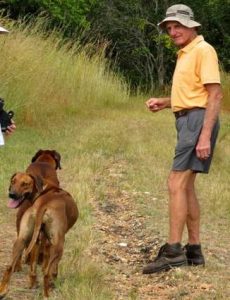
Rolf Hangartner and his beloved ridgebacks
Rolf was always an enthusiastic and passionate lover of nature, the great outdoors, kopjes, mountains and the bush. He and his family made many adventurous trips into wilderness areas in the region in their Land Rover. Rolf also continued playing tennis, squash and table tennis with enthusiasm.
In 1994 Rolf fulfilled his boyhood dream by purchasing Cannonkopje farm near Mutorashanga where he and Jennifer established a wildlife conservancy. Two dams were built in the beautiful, kopje-studded landscape and several species of plains game – giraffe, sable, wildebeest, impala and zebra – were introduced to add to the resident population of kudu, oribi, duiker, klipspringer, warthog and baboon.
Rolf also established a project for the captive breeding of Wattled Cranes and devoted considerable time, effort and finances into building a centre with many large pens, succeeding in getting these magnificent cranes to breed for the first time in captivity. The species was then still fairly abundant in the farm wetlands on the eastern side of the Great Dyke, but soon came under severe pressure after the events of the year 2000. Today no Wattled Cranes are left in the area and the population in the Midlands is under serious threat.
After his wife passed away in 2001 and his sons had all left the country, Rolf lived alone with his Ridgebacks, his game animals and his books, helped by his faithful and dependable staff. He limited his trips to town to as few as possible and he was perfectly happy. He was a generous and welcoming host to many people, not least to members of the Tree Society, the Aloe and Cactus Society, the Ornithological Society and the Mountain Club, whose members regularly climbed Canon Kopje over a period of 25 years. Friends visited him frequently for a few days at a time, all of whom very much enjoyed his company and the tranquil surroundings he lived in.
Eighty-one years of age, Rolf had remained fit – a bush rambler and rock-jumper of note, full of youthful enthusiasm which remained with him in good times and in bad. His pace when walking through bush country was legendary and the writer had to draw his attention to some non-existent rare bird on occasions to slow him down and so be able to keep up with him!
Rolf died in a traffic accident on his way back from town to Canon Kopje on the evening of 21st August 2014. He was laid to rest next to Jennifer in a secluded spot amongst granite boulders and big trees, a fitting place for one who loved nature, all things bright and beautiful and all creatures great and small.
We mourn the passing of a good friend.
R. C-R


